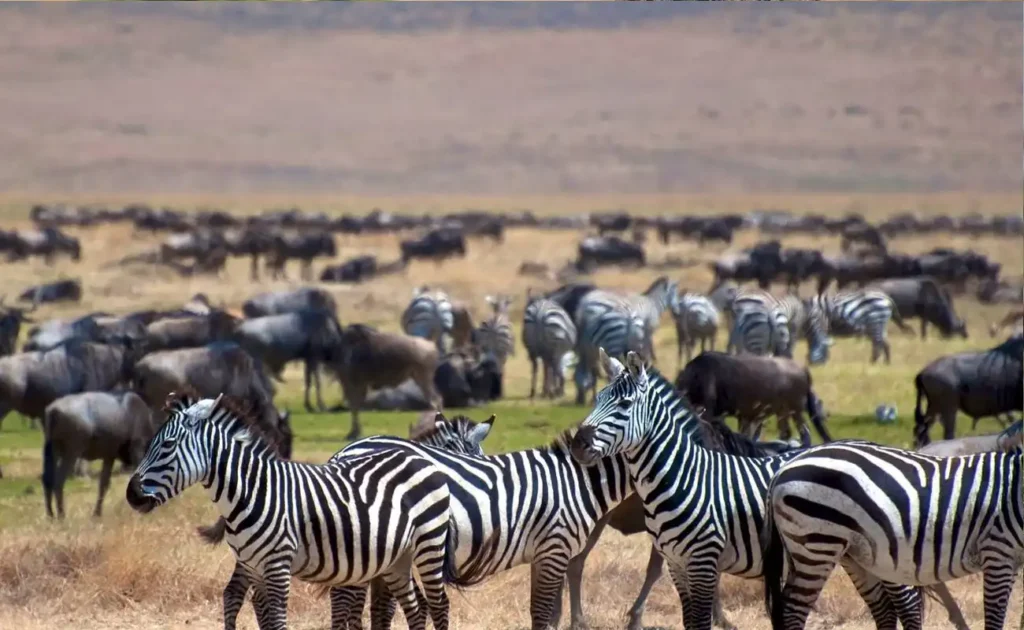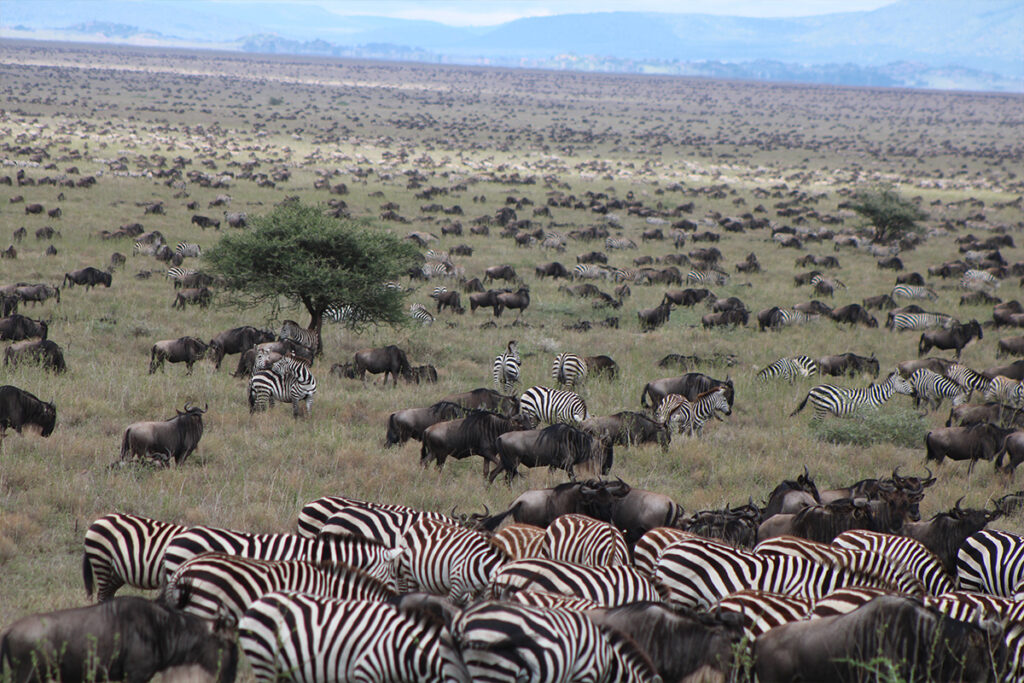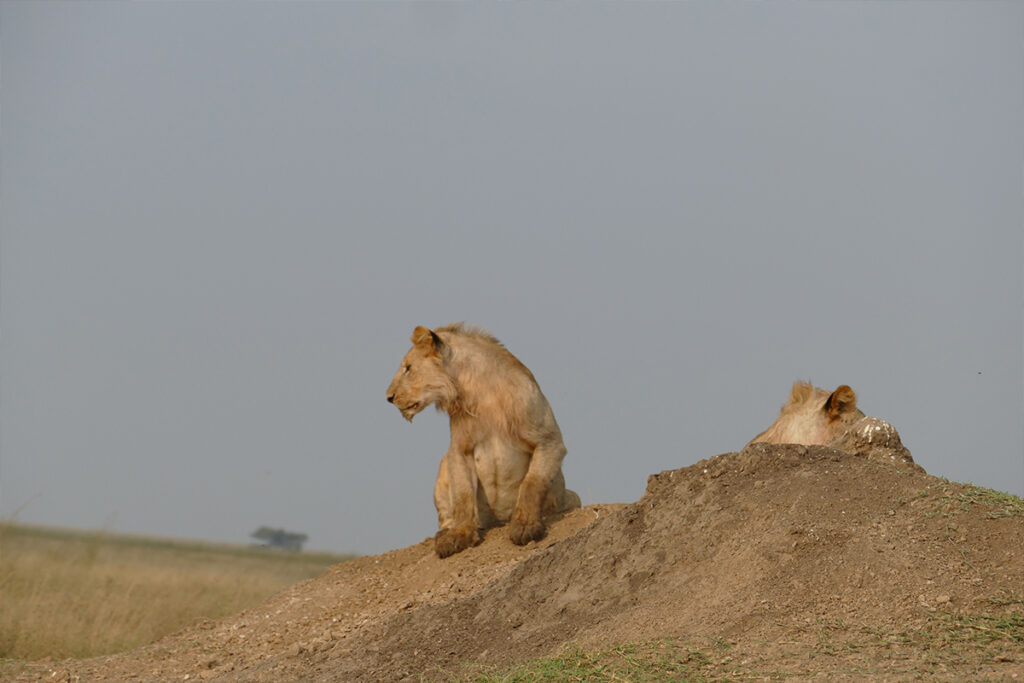In the wilderness of Tanzania, more than 16,000 tourists per month are captivated by the mesmerizing annual migration of over a million wildebeest. This awe-inspiring spectacle forms part of the allure of a luxury safari. Guided by expert naturalists, travelers bear witness not just to wildlife but to the intricate harmony of nature’s grand theatre.
The luxury Tanzania safari immerses guests in unparalleled opulence while connecting them to the roots of conservation. Tracing back to the era of Ernest Hemingway, safaris have evolved into environmentally conscious adventures, marked by a 35% increase in eco-friendly camps. Combining plush accommodations with conservational integrity, these experiences cater exquisitely to the environmentally aware luxury traveler.

Luxury Tanzania Safari: A Refined Wilderness Experience
Embarking on a luxury Tanzania safari offers a blend of wild elegance. You get to see stunning landscapes filled with extraordinary wildlife. The Serengeti and Ngorongoro Crater are just two of the breathtaking places to explore. These areas teem with creatures like elephants, lions, and rhinos. According to the article, upcoming safari trends for 2025 will bring even more exciting adventures.
A key part of this experience is the luxury accommodations. Picture waking up to the sounds of nature in a beautifully adorned tent. These tents are not ordinary; they are equipped with soft beds and private bathrooms. You can learn more about the best fancy tents in Tanzania here is the post, which showcases just how luxurious these places can be. This blend of comfort and adventure creates memories that last a lifetime.
Beyond relaxation, a luxury safari involves exciting daily activities. Game drives provide close encounters with charismatic wildlife. Walking safaris offer a slower pace with expert guides sharing insights. There’s also the option of hot-air balloon rides over the savannah, where views are unmatched. Such experiences bring the raw beauty of Tanzania right to your doorstep.
Choosing the right luxury safari involves planning. Costs vary depending on the time of year and length of stay. Many environments also focus on eco-friendly practices, ensuring tourism benefits both nature and local communities. Travelers often explore multiple parks to maximize their adventure. According to this post, thoughtful planning can help create the perfect itinerary, allowing visitors to fully immerse themselves in Tanzania’s wonders.
Exploring Tanzania’s Wildlife: The Highlights of a Luxury Safari
Tanzania boasts an incredible variety of wildlife, making it a standout destination for any nature lover. The iconic Big Five—lions, elephants, buffalo, leopards, and rhinos—roam freely across the diverse landscapes. Safaris often start early in the morning when animals are most active. Expert guides help you spot these magnificent creatures, sharing fascinating facts along the way. It’s an adventure that connects you deeply with nature.
Beyond the Big Five, there’s a world of unique species to discover. Zebras and giraffes graze across the vast plains. Colorful birds flit through the skies, filling the air with song. You might even encounter stealthy hyenas or the elusive cheetah sprinting across the savannah. Each day offers new surprises and unforgettable moments.
The environments themselves are as varied as the animals. You can visit lush forests, expansive grasslands, and striking highlands all in one trip. This diversity not only supports a wide range of wildlife but enhances the entire safari experience. With each new setting, the atmosphere shifts, providing fresh vistas and varying habitats. Observing animals in their natural settings is an enriching part of the journey.
Luxury safaris often offer special excursions to enrich your wildlife encounters. Options include night drives to see nocturnal animals and guided walking safaris for a quieter exploration. Some safaris also allow visits to local Maasai villages, offering a cultural perspective alongside wildlife appreciation. Engaging in these activities deepens understanding and appreciation for both the animals and their environments. Every moment spent exploring Tanzania’s wildlife becomes a treasured memory.
The Pinnacle of Comfort: Accommodation in Tanzania’s Luxury Safaris
Accommodation on a Tanzania luxury safari is a highlight that blends comfort with the beauty of the wild. Visitors can expect lavish tented camps that redefine traditional camping. These tents are equipped with king-sized beds, elegant furnishings, and private bathrooms. Imagine gazing at stars from your own deck, with the sounds of nature providing a soothing soundtrack. It’s an experience that merges luxury with the wonders of the wilderness.
Many camps and lodges are positioned in prime locations, offering stunning views and easy access to wildlife. High-end lodges often sit by waterholes, attracting animals close to your doorstep. This allows guests to enjoy wildlife sightings without leaving their accommodation. Such strategic placements maximize the safari experience while maintaining comfort and luxury. Morning coffee on your porch may come with the sight of elephants strolling by.
The culinary experiences in these lodges are equally impressive. With skilled chefs and fresh local ingredients, meals are nothing short of gourmet. Guests can savor fine dining dishes while surrounded by breathtaking landscapes. Some lodges offer outdoor dining experiences, creating a fusion of delicious food and the great outdoors. Mealtimes become cherished moments during the safari journey.
Apart from luxury, accommodations also focus on sustainability and cultural immersion. Many lodges use eco-friendly practices to minimize their environmental impact. By incorporating solar energy and water conservation techniques, they protect the natural beauty that surrounds them. Some accommodations also provide opportunities to engage with local communities, enriching the stay with cultural insights. This balance of luxury, care for the environment, and cultural connection elevates the Tanzania safari experience.
Honoring Conservation: Sustainability in Tanzania’s Luxury Safaris
Conservation is at the heart of luxury safaris in Tanzania, integrating sustainable practices to protect the environment. Many safari lodges prioritize eco-friendly designs, utilizing solar power and minimizing water usage. These efforts ensure that tourism footprints remain light, preserving Tanzania’s natural beauty. By focusing on sustainability, the region balances tourism with long-term ecological health. This approach benefits both wildlife and local communities.
A key element of sustainability in Tanzania’s luxury safaris involves wildlife conservation programs. Lodges work closely with organizations to support anti-poaching efforts and habitat preservation. Guests often have the opportunity to learn about and contribute to these initiatives. This not only enhances their safari experience but also fosters a deeper connection to the cause. Conservation programs are vital for protecting endangered species and maintaining biodiversity.
Local community engagement is another important aspect of sustainable safaris. Many lodges employ locals, providing valuable job opportunities and supporting the economy. Some even partner with villages to offer authentic cultural experiences for guests. This partnership promotes cultural understanding while benefiting local residents. By involving communities, safaris create a positive impact beyond just tourism.
Education and awareness are integral to promoting sustainability. Guests are often informed about the importance of conservation and how they can help. This can include simple actions like recycling or more substantial contributions to conservation projects. By raising awareness, lodges cultivate a sense of responsibility among visitors. This knowledge and commitment to sustainable travel extend beyond their safari adventure.
In addition to individual efforts, there are broader initiatives supporting eco-friendly tourism. National parks and reserves implement regulations to safeguard ecosystems. Private reserves also play a crucial role in conservation, often funding projects to protect wildlife. These collective efforts ensure that Tanzania remains a top destination for sustainable tourism. Conservation and luxury can coexist, offering an enriching and responsible travel experience.
Booking Your Journey: Pricing and Scheduling a Luxury Tanzania Safari
Planning a luxury Tanzania safari involves understanding the costs and best times to visit. Safari prices vary based on factors like the season, duration, and type of accommodation. High season, from June to October, typically offers the best wildlife viewing but comes with higher prices. Alternatively, the green season offers more budget-friendly rates while still providing a rich experience. Allocating your budget wisely ensures a well-rounded and unforgettable safari.
When scheduling your safari, consider the experiences you want to include. Many travelers plan trips around the Great Migration, a breathtaking spectacle of wildebeest crossings. For bird enthusiasts, the wet season brings vibrant birdlife to the region. It’s important to book early, especially for popular lodges and tours during peak times. Prior planning helps you secure your ideal safari itinerary with your preferred options.
Duration is another critical aspect of safari planning. Safaris usually range from three to ten days, depending on your schedule and desires. Shorter safaris focus on a single park, while longer ones explore multiple reserves, offering a broader wildlife experience. With more days, guests can enjoy a leisurely pace and cover more ground. Balancing schedule and interests ensures a fulfilling adventure.
Booking a luxury safari often includes additional services and amenities. Many packages come with guided game drives, meals, and luxurious accommodations. Some even offer extras like hot-air balloon rides or walking safaris. Understanding what’s included in your package helps avoid surprises and ensures you have everything needed for a seamless experience. Comparing offers lets you find the best fit for your travel goals.
Finally, consider travel logistics such as flights and visas. Whether flying into Kilimanjaro International Airport or Dar es Salaam, it’s important to check visa requirements and vaccinations. Your safari provider can often assist with these arrangements, simplifying the process. Proper preparation means you can focus on enjoying the vibrant landscapes and abundant wildlife once you arrive. This attention to detail enhances the overall safari journey.

Frequently Asked Questions
Embarking on a luxury Tanzania safari is both exciting and a bit daunting. Here are some common questions that can help you better prepare for this extraordinary experience.
1. What is the best time of year to visit Tanzania for a safari?
The best time to visit Tanzania for a safari usually depends on what you wish to see. From June to October is the dry season and a fantastic time for watching the Great Migration in the Serengeti. This period offers excellent wildlife viewing as animals gather around water sources, making them easier to spot.
If you’re interested in bird watching, the wet season from November to April is ideal. During this time, many migratory birds are present, and the landscape turns lush and green. However, some roads might be less accessible due to rain, so this should also be considered when planning your itinerary.
2. Are Tanzania safaris family-friendly?
Tanzania safaris can be very family-friendly, offering activities that engage both kids and adults. Many luxury camps provide family suites or tents and sometimes offer special programs tailored for children. This ensures that the youngest explorers also have educational and fun experiences.
Activities such as guided nature walks teach children about wildlife and conservation. However, certain age restrictions may apply for specific activities like walking safaris. Therefore, it’s best to confirm age-appropriate excursions when planning a family safari trip.
3. What should I pack for a luxury Tanzania safari?
When packing for a luxury Tanzania safari, comfort and practicality should guide your choices. Lightweight, neutral-colored clothing is highly recommended, as it helps with blending into the surroundings. Include essential items like a wide-brimmed hat, sunglasses, and a good pair of binoculars for better wildlife viewing.
Don’t forget to pack your camera, with extra batteries and memory cards, to capture memorable moments. If traveling in the cooler months, pack a light jacket for chilly mornings and evenings. Most lodges provide toiletries, so focus on packing essentials and gear that enhance your safari experience.
4. How do I choose between the Serengeti and the Ngorongoro Crater?
Choosing between the Serengeti and Ngorongoro Crater is challenging as both offer unique experiences. The Serengeti is famous for the Great Migration and vast plains filled with diverse wildlife. It’s perfect for those who wish to witness dramatic migrations and expansive landscapes.
On the other hand, the Ngorongoro Crater is a UNESCO World Heritage site, known for its dense animal populations within a restricted area. It provides opportunities for intimate wildlife encounters and is rich in both history and breathtaking scenery. Visiting both, if time allows, would offer a comprehensive safari experience.
5. Is a luxury safari eco-friendly?
Yes, many luxury safaris in Tanzania are conscious of their ecological footprint. They integrate sustainable practices to ensure minimal impact on the environment. Many lodges use solar power and have waste management systems to protect the surrounding natural areas.
Guests are often encouraged to participate in conservation efforts and learn about local wildlife preservation practices. By focusing on sustainability, these safaris not only provide a lavish experience but also contribute positively to conservation and community development.



